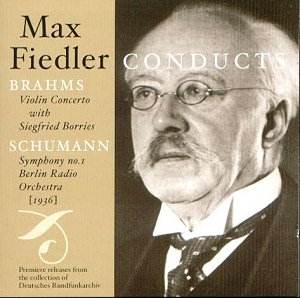AVAILABILITY
www.musicandarts.com
In his judiciously written biographical essay
Mark Kluge aptly notes that Fiedler’s association with Brahms
is not quite as authoritative as some have believed it to be.
It’s true that Fiedler played the piano solo at a rehearsal of
the Second Concerto, at the subsequent concert of which Brahms
was the soloist – but it has always been alleged that Brahms had
heard Fiedler conduct the symphonies and had thus added his imprimatur
to the younger man’s conducting. For this there is no evidence
at all. Though his conducting career began quite late Fiedler
soon began to travel internationally – New York, London – and
was soon appointed Music Director in Boston, a position he held
until he returned to Germany in 1908 and a post in Essen.
That his recordings were relatively few in number
and that so many were of the music of Brahms has led, perhaps
inevitably, to the view that if he wasn’t a Brahms acolyte then
he was, at least, a specialist. He recorded the Second (1931)
and the Fourth (1930) – though the dates given in brackets are
subject to small controversy and may be out by a year – though
not the odd numbered symphonies. The Second Piano Concerto, which
he’d played on that famous occasion so many years before in 1883,
he recorded with Elly Ney in 1939. The Academic Festival Overture
had long before, in 1931, also been recorded. We can now add to
Fiedler’s Brahmsian discography this live performance of the Violin
Concerto with the eminent soloist-leader of the Berlin Orchestra,
Siegfried Borries, then twenty-four. It’s a major discovery for
Fiedler devotees. He opens the first movement slowly, grandly,
with a touch of rhetorical brooding but soon accelerates into
lyrical passages. Indeed his marshalling of the score throughout
is marked by powerful concentration and strong romantic gestures.
His soloist, Borries, was at the early stages of his distinguished
career; indeed had only been leader of the orchestra for a couple
of years. His vibrato can take on a youthful beat from time to
time, sometimes tending toward the smeary; but his eloquently
expressive response to the first movement shows itself in all
sorts of telling little details and the most fundamental is his
vibrato usage. He responds with ardour - but with rather too much
differentiated tone - to the lyrico-expressive demands made on
him by the score. The result is emotive but occasionally too fractured
a response. Fiedler meanwhile offers flexibility and nuance in
support – strong bass accents predominate – whilst Borries’ arsenal
of portamenti are instructively quick but pervasive; he even makes
a downward L-shaped portamento with a very fluttery quality to
it indeed (I liked it but it certainly won’t be to all tastes).
The slow movement has a good oboe solo. Borries
brings his relatively small tone to bear with acumen – he transmits
colour through a coiled tone with a degree of warmth and affection.
I much prefer him to a later Berlin Philharmonic leader now being
touted as the Great German Violinist, Gerhard Taschner. Borries’
reading is affectionate without the aristocratic bearing that
some others bring here. His finale is good – no gypsy abandon,
perhaps, but equally no vulgarity. It possesses verve, which is
important, if more than somewhat undisciplined orchestrally and
the orchestra is not on especially scrupulous form throughout,
it has to be said.
Coupled with the Brahms is Schumann’s First Symphony.
This is a far more contentious reading and to those indifferent
to this kind of performance it will sound maddeningly indulgent.
As with the Brahms it again opens emphatically but it’s also full
of rhythmic retardation and a pervasive, creeping sense of etiolation.
When we reach the eruptive Allegro section of the first movement
we have, so to speak, rhythmically lost our bearings. Tempo fluctuations
abound in the best subjectivist tradition and a sense of almost
wilful late nineteenth century drama. I have to say I didn’t detect
much of a divining thread running through the movement; all I
did find was sectionality even though one can’t but admit the
sonorous and emotive texture of much of the conducting. The slow
movement is again objectively terribly slow. This leads to cumulative
successive peaks of tension and orchestral crisis – tension and
release – but ones that carry with them inherent limitations and
dangers. The expressive depth that is certainly present does become
somewhat compromised by the lack of spine and drive. The final
two movements go considerably – though by no means absolutely
– better. I was glad to hear the performance but it’s one that
I struggled with for some time.
Now for the problem and that’s the sound. Though
it’s stated clearly that this is a release from the collection
of the Deutsches Rundfunkarchiv the sound quality is distinctly
muddy. After a while one’s ear adjusts but there’s a deal of adjusting
to be done. No transfer engineer or process is noted so I rather
wonder how closely this resembles the original in the Berlin archive.
I hope it won’t spoil enthusiasm for the disc which is most eloquent
proof, in the case of the Brahms, of Fiedler’s standing in repertoire
congenial to him and, as it were, him to it.
Jonathan Woolf
